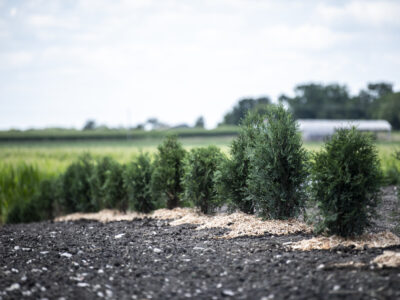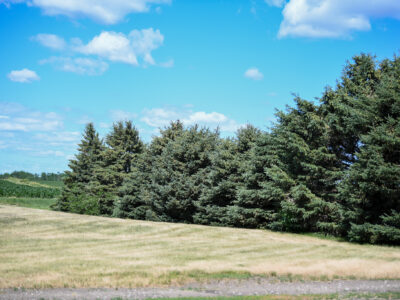Source: Iowa State University Extension and Outreach, RG 702 Revised February 2013; Prepared by Jeff Iles, extension horticulturist
To read more, visit http://bit.ly/11Q39kd
Selecting a single “good tree” for your yard or several hundred for your community will be more rewarding if you take time to critically evaluate the proposed planting site and the reasons for planting trees on that site.
Consider sunlight and soil
The amount of sunlight and time of day it illuminates the site will determine what kind of tree can be planted. For example, hackberry will tolerate late afternoon sun and blazing heat and would be a far better choice than pagoda dogwood on southern or western exposures.
Soil conditions also are important. Most trees prefer well-drained soils. However, several trees, like baldcypress and river birch, will grow quite well on chronically wet sites. Tree species also vary in their ability to tolerate alkaline soils. Pin oak is the classic example of a tree intolerant of alkaline conditions; it turns a sickly yellow on soils with a pH above 7.2. Bur oak and chinquapin oak will thrive in alkaline soils.
Match tree to site needs
What special characteristics, traits, or tolerances will the trees need to succeed on the proposed site?
- If trees will border a street or highway, will they tolerate de-icing salt spray whipped up by passing vehicles after a winter storm? Do your prospective trees have insect- and disease-free track records?
- Do their growth habits complement the site? For example, have you selected upright, tightly pyramidal, or columnar-growing species for boulevards and other confined spaces that can’t accommodate wide-spreading trees?
- Have you considered the mature height of the tree? This is especially important below utility lines.
- What about growth rate and longevity? Have you chosen sturdy, long-lived trees with moderate growth rates or fast growing, short-lived species?
- Finally, do your intended trees have ornamental features that command attention throughout the year? Or, are they “couch potatoes” that flower for a few days in spring and take the rest of the year off?
Order plants
Once you’ve chosen the species, how do you find quality trees? Distant wholesalers may provide substantial discounts for large orders, but for most communities, the most cost-efficient option is to order plants from a reputable local wholesale or retail nursery. By purchasing locally you will avoid shipping costs and give your tree selection committee a chance to inspect trees before delivery. Remember, the earlier you place your order or visit local nurseries, the more likely you are to find the best trees.
Inspect trees
Since trees represent a sizable investment, take time to carefully inspect them before purchasing, and/or before planting. Any plants differing in size, age, species, or condition from what was ordered should not be accepted and should be returned to the nursery for refund or suitable replacement. Here are some specifics to check.
The general appearance of a tree will reveal much about its quality and potential for success when transplanted. Is the trunk straight and is the crown symmetrical? Does the tree show signs of current season growth? Signs of viability include expanding buds, new leaves, and elongated shoots. Is the tree free from disease and insect damage? Once a tree successfully passes these qualifying tests, it can be examined more closely.
Shade trees should have a strong, well-defined central leader with equally spaced branches forming a symmetrical crown. Trees having multiple leaders, rubbing, crossing, and/or overly-crowded branches have not been properly pruned. Improper pruning cuts (flush cuts) also are warning signs.
Next examine the trunk. Discolored, sunken, or swollen areas in the trunk serve as additional warning signs to tree buyers. Bark cuts and scrapes are undesirable. Trees with trunk wounds have been handled inappropriately and should be avoided. Finally, trees with visible wood borer (insect) galleries in the trunk, and those showing signs of sunscald or cracking should be rejected.
If a rootball looks disproportionately small compared to the trunk and crown, the tree should be rejected. The ball of earth should not be excessively wet or dry and should be securely held together by burlap and stout twine, and for larger trees, a wire basket. The trunk should be centered in the rootball and should not move independent of the rootball.
Trees purchased as “container-grown” should be well-rooted and firmly established in the container in which they are sold. The root mass should retain its shape and hold together when removed from the container. Attempting to remove a recently potted tree from its container can be a frustrating and costly experience, particularly if the tree dies because of root disturbance or root desiccation.
Trees planted with poorly developed roots are subject to drought stress, wind-throw, and weak growth. If you purchase spring-potted trees, you may need to keep them in the pots for a few weeks to allow roots to grow. Bare-root trees should be held in a cool, shady area with their roots protected from drying by moist burlap or packing until time of planting. Roots should be damp and flexible.
Price indicates quality
Occasionally nurseries will offer “park grade” or lower grade trees. These trees have minor trunk damage, poor form, or other obvious defects and usually carry a much smaller price tag. Beware! You get the quality you pay for.



